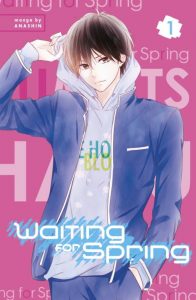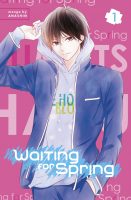By Anashin | Published by Kodansha Comics
 Mitsuki Haruno is a first-year in high school who has always had trouble making friends. Her luck begins to change when she befriends the most popular quartet of boys in school. If someone read those sentences to me and asked me to guess in which magazine this manga was serialized, I’d say Dessert, based on past offerings we’ve seen from them (like Say I Love You.). And I would be right.
Mitsuki Haruno is a first-year in high school who has always had trouble making friends. Her luck begins to change when she befriends the most popular quartet of boys in school. If someone read those sentences to me and asked me to guess in which magazine this manga was serialized, I’d say Dessert, based on past offerings we’ve seen from them (like Say I Love You.). And I would be right.
The fact that it’s a familiar premise doesn’t preclude Waiting for Spring from being enjoyable, however. Although the four boys can be almost instantly categorized into standard roles based on their appearance—the playful one, the intellectual one, the hotheaded one, the princely one—I appreciated that, like typical teenage boys, they are still occasionally jerks. Oh, sure, they’re idealized and do things like try to cheer up little kids through the power of basketball, but at least they’re not saints.
 I also quite liked Mitsuki as a character. I could foresee a version of this story in which her failures to initiate social interaction with others might be frustrating, but that’s not the case here at all. The key seems to be Mitsuki’s honesty about the past experiences that are holding her back in the present, and by the end of the third volume she has made two female friends. Reina is, awesomely, a major fujoshi and envisions the four boys (all of whom are on the basketball team) in romantic pairings. I love the little background gags of her taking surreptitious pictures of them. Maki is a member of the girls basketball team who, unbeknownst to Mitsuki, also has a thing for princely Asakura.
I also quite liked Mitsuki as a character. I could foresee a version of this story in which her failures to initiate social interaction with others might be frustrating, but that’s not the case here at all. The key seems to be Mitsuki’s honesty about the past experiences that are holding her back in the present, and by the end of the third volume she has made two female friends. Reina is, awesomely, a major fujoshi and envisions the four boys (all of whom are on the basketball team) in romantic pairings. I love the little background gags of her taking surreptitious pictures of them. Maki is a member of the girls basketball team who, unbeknownst to Mitsuki, also has a thing for princely Asakura.
We also meet Aya, the childhood friend whom Mitsuki thought was a girl. Turns out (no real surprise) that he is a boy and is determined to win Mitsuki’s affections. He’s insistent to a troubling degree, but again, I appreciate that Mitsuki is firm in her refusals, even managing to defuse conflict between Aya and Asakura by proposing that she’ll go on the date Aya wants after the inter-high tournament, but that Asakura will come too and it’ll be a fun group thing. I get that we’re supposed to appreciate how much Aya’s friendship meant to Mitsuki when she was young, given that she had no other friends, but I wonder… are readers really supposed to like this guy? At least his presence spurs Asakura (generally sleepy and/or oblivious) to realize what his feelings for Mitsuki are.
 But will he act on those feelings? The boys on the basketball team are not allowed to date. I did find it strange that although these boys talk about how much basketball means to them, because this is shoujo manga, we see sadly little of it. In volume three, the inter-high preliminaries have begun and in the space of 1.5 pages, the boys have won five games. I know this isn’t a sports manga, but c’mon… I’d like to see more than that! Another thing to appreciate about Mitsuki is that, while many of the team’s other female fans are just there to look at the cute boys, she understands how important the game is to Asakura and overcomes her shyness and orchestrate a cheering section when they fall behind during a practice game. Too, I greatly appreciate that she hasn’t had to deal with any mean girls warning her away from the boys. (Reina’s occasional “grr” reactions at girls hanging around them are enough.)
But will he act on those feelings? The boys on the basketball team are not allowed to date. I did find it strange that although these boys talk about how much basketball means to them, because this is shoujo manga, we see sadly little of it. In volume three, the inter-high preliminaries have begun and in the space of 1.5 pages, the boys have won five games. I know this isn’t a sports manga, but c’mon… I’d like to see more than that! Another thing to appreciate about Mitsuki is that, while many of the team’s other female fans are just there to look at the cute boys, she understands how important the game is to Asakura and overcomes her shyness and orchestrate a cheering section when they fall behind during a practice game. Too, I greatly appreciate that she hasn’t had to deal with any mean girls warning her away from the boys. (Reina’s occasional “grr” reactions at girls hanging around them are enough.)
So, yes, this is a low-key series that isn’t breaking any new ground. That said, I still like it. The sweet moments between Mitsuki and Asakura take me back to adolescence when the first time you hold hands with someone is a tremendously big deal and the art style is attractive. The conclusion seems pretty obvious already, but I expect I’ll enjoy getting there all the same.
Waiting for Spring is ongoing in Japan, where it is up to eight volumes. Three volumes are currently out in English, with the fourth scheduled for release next week.
Review copies provided by the publisher.


